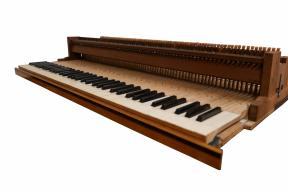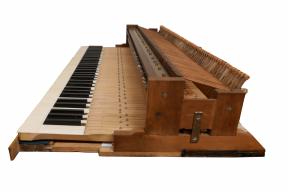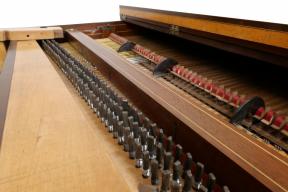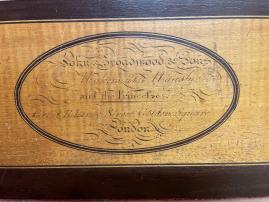Grand piano (nr. 4773)
john broadwood & Sons
london 1810
A parallel to Broadwood's grand for Ludwig van Beethoven (today Budapest, ex Franz Liszt; more).
Mechanism: english
Range: 6 octaves, 73 keys, C1 – c4
Levers, Pedals: 2 Pedals, split right pedal (l. to r.): una corda; dampers Bass; dampers Treble
Lyra (new replacement 1996)
Stringing:
Brass: C1 – G#
Iron: A – c4
Signature: „John Broadwood & Sons // Makers to his Majesty // and the Princesses. // Great Pulteney Street Golden Square // London“




The instrument bears the production number "4773" and was delivered on August 7, 1810, to the first customer, John Weston, in Brackley near Northampton (according to the accounts book, Broadwood archives; transcription: "A 6 Octave GlF with Legs N 4773 and Cover, and boots of the // L. Keyvett Sundr and a Case for Canterbury, yourown // addressed John Weston Esqr Brackley, Northamptonshire // delivered at the Oxford Arms Norwich Lane goes by // Malins & Co Waggons Mays").
This type of grand piano represents the standard product of the company at the time under the product name "elegant" and showcases some distinctive features of this model, such as the split damper pedal and the typical craftsmanship, which should safely withstand the long transport routes by cart, as seen here, as well as ship freight, as happened to the Beethoven's piano.
The "elegant" model influenced English piano manufacturing around and after 1800. The body shape and the construction with dark fine wood veneer (mahogany or corresponding imitation) are characteristic of the outer design of that time. The angular rear end and the simple curve of the side wall were soon imitated in France and, after a few decades, also in Central Europe. Typical for English grand pianos in general and the products of the Broadwood company in particular are the design, which could be further enhanced according to customer wishes with luxurious decorations (brass fittings, Wedgwood decorative ceramics), and the six-octave range from C to c4, which does not meet the requirements of continental piano literature. For example, in Vienna a range from F to f4 was common, and the piano compositions of the Haydn-Beethoven-Schubert era were specifically based on that (and are only playable to a limited extent on an English piano of that time). These different developments are an indirect consequence of the Napoleonic Continental Blockade, which prevented English goods, such as pianos, from being exported to continental Europe, as well as continental goods to Britain and overseas. During this period, piano aesthetics developed quite differently in England and on the continent.
The Broadwood company has existed since 1728, when Burkhart Tschudi from Glarus opened his own harpsichord workshop after his apprenticeship with Hermann Tabel in London. Following (by now Anglicized) Burkat Shudi's retirement in 1771, the business passed to his namesake son and his son-in-law (who had previously been an apprentice and journeyman), John Broadwood, who soon took over sole management. In 1777, together with Americus Backers and Robert Stodart, he developed a mechanism that subsequently became known as "English action," and became one of the standard designs for piano actions (alongside the typically Central European Viennese action, Cristofori's original action, and the later double repetition action of the Erard company). The company name still commonly used today, "John Broadwood & Sons," was introduced with Thomas Broadwood's entry into the business in 1808.
The extensively preserved company records (today in the Surrey History Centre in Woking) reveal not only the development through the generations of the descendants of Tschudi and Broadwood, who led the company until 2008, but also valuable information regarding the development and spread of the hammer piano up to the present day.




